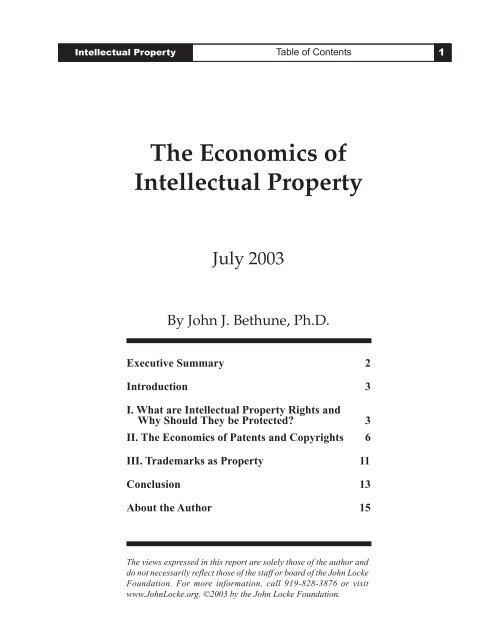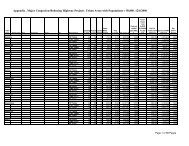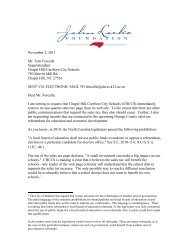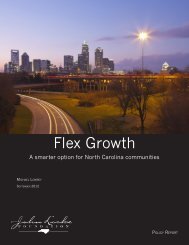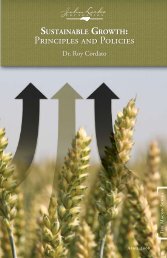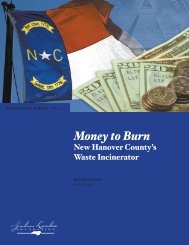The Economics of Intellectual Property - John Locke Foundation
The Economics of Intellectual Property - John Locke Foundation
The Economics of Intellectual Property - John Locke Foundation
You also want an ePaper? Increase the reach of your titles
YUMPU automatically turns print PDFs into web optimized ePapers that Google loves.
<strong>Intellectual</strong> <strong>Property</strong><br />
Table <strong>of</strong> Contents<br />
1<br />
<strong>The</strong> <strong>Economics</strong> <strong>of</strong><br />
<strong>Intellectual</strong> <strong>Property</strong><br />
July 2003<br />
By <strong>John</strong> J. Bethune, Ph.D.<br />
Executive Summary 2<br />
Introduction 3<br />
I. What are <strong>Intellectual</strong> <strong>Property</strong> Rights and<br />
Why Should <strong>The</strong>y be Protected? 3<br />
II. <strong>The</strong> <strong>Economics</strong> <strong>of</strong> Patents and Copyrights 6<br />
III. Trademarks as <strong>Property</strong> 11<br />
Conclusion 13<br />
About the Author 15<br />
<strong>The</strong> views expressed in this report are solely those <strong>of</strong> the author and<br />
do not necessarily reflect those <strong>of</strong> the staff or board <strong>of</strong> the <strong>John</strong> <strong>Locke</strong><br />
<strong>Foundation</strong>. For more information, call 919-828-3876 or visit<br />
www.<strong>John</strong><strong>Locke</strong>.org. ©2003 by the <strong>John</strong> <strong>Locke</strong> <strong>Foundation</strong>.
2 Executive Summary<br />
<strong>Intellectual</strong> <strong>Property</strong><br />
<strong>The</strong> <strong>Economics</strong> <strong>of</strong> <strong>Intellectual</strong> <strong>Property</strong><br />
Defining and protecting intellectual property, generally referred to as patents and copyrights,<br />
and trademarks have been legal and political endeavors for at least the last<br />
several hundred years. In the United States, protections <strong>of</strong> intellectual property are<br />
enshrined in the Constitution. This paper discusses the concept <strong>of</strong> intellectual property from<br />
an economic perspective.<br />
Strictly speaking, patents and copyrights are grants <strong>of</strong> monopoly privilege. Standard economic<br />
analysis typically suggests that monopolies are harmful to society. But an exception to<br />
this standard analysis is almost always made in the area <strong>of</strong> intellectual property protection.<br />
Using simple economic analysis it can be demonstrated that these particular kinds <strong>of</strong> monopoly<br />
grants are necessary and beneficial.<br />
It can be shown that protecting intellectual property creates important incentives to pursue<br />
new research and create new works <strong>of</strong> art, and without these protections many innovative<br />
works would never be pursued. Because <strong>of</strong> this, patents and copyrights are a form <strong>of</strong><br />
monopoly that can yield benefits to society in excess <strong>of</strong> the costs that are incurred. This study<br />
emphasizes the point that the value <strong>of</strong> these benefits is diminished, and the costs increased,<br />
the longer the period continues. Simple graphical analysis demonstrates that a time period<br />
can be chosen for both copyright and patent protection that will maximize the benefit to<br />
society, while minimizing the harmful distortions that monopolies create. As we will see, this<br />
analysis is applicable to patents and copyrights, but not trademarks.<br />
Special attention is focused on the benefits and costs <strong>of</strong> various legal regimes. Separate<br />
sections address how current law protects copyrights and patents. At present, copyright protection<br />
for works <strong>of</strong> literature, music, movies, etc. extends for the life <strong>of</strong> the author plus 70<br />
years. <strong>The</strong> analysis suggests that this length <strong>of</strong> time is excessive, and that it would benefit<br />
society to shorten the time period for which these materials are given protection. On the other<br />
hand, it is probably the case that in some circumstances, society would benefit from extending<br />
patent protection for inventions and new products beyond its current 17 years. For example,<br />
it is <strong>of</strong>ten the case in the research and development <strong>of</strong> new drugs, that the monetary<br />
and time costs <strong>of</strong> development are not fully compensated under the current legal structure.<br />
Trademark protection is treated separately from copyright and patents. <strong>The</strong> study concludes<br />
that trademark laws do <strong>of</strong>fer optimal protections, particularly from the perspective <strong>of</strong><br />
consumers.
<strong>Intellectual</strong> <strong>Property</strong> Introduction<br />
3<br />
Introduction<br />
This paper discusses the concept <strong>of</strong> intellectual property, mainly from an economic perspective.<br />
<strong>The</strong> concepts <strong>of</strong> copyright, patent and trademark are each addressed. In addition<br />
the paper will briefly examine the history <strong>of</strong> intellectual property rights and discuss the economic<br />
analysis <strong>of</strong> the contemporary intellectual property law. Let us begin by considering a<br />
few real-world examples facing our society.<br />
Today is your birthday and a large group <strong>of</strong> your friends and family have a party for you<br />
in the park, where they sing the “Happy Birthday to You” song. <strong>The</strong> entire group is now in<br />
violation <strong>of</strong> U. S. copyright law. A barber shop leaves the radio on the golden oldies channel.<br />
Unless the owner is paying royalties to a copyright clearance center, he is in violation <strong>of</strong> U. S.<br />
copyright law. Mac McDonald wants to open a hamburger stand and call it by his last name.<br />
He also wants to call his larger hamburger by his first name. Trademark law would not allow<br />
this.<br />
In California, because <strong>of</strong> strict emissions standards, only one firm produces the type <strong>of</strong><br />
gasoline permissible for sale under California law. This leaves California consumers paying<br />
40 to 50 cents more per gallon than the national average. Patent law prevents other firms from<br />
producing this relatively simple reformulated gasoline, and competing with the current monopoly<br />
supplier.<br />
Pharmaceutical companies spend tens <strong>of</strong> millions <strong>of</strong> dollars developing new drugs to<br />
prevent and cure diseases. Once developed, the drug is copied and distributed internationally<br />
by firms that can choose to ignore U. S. and international patent law. Further, price controls<br />
in other countries force the pharmaceutical companies to sell their (<strong>of</strong>ten lifesaving)<br />
products at a value that will not cover the research and development costs. Are these practices<br />
slowing the development <strong>of</strong> new drugs and treatments?<br />
All <strong>of</strong> the above situations involve the concept <strong>of</strong> intellectual property and how we, as a<br />
society, try to afford protection through law. Recent trends in intellectual property law have<br />
been to expand protections in the area <strong>of</strong> copyright, while, on the other hand, seeking to limit<br />
the protections afforded by patents. <strong>The</strong>se are important public policy considerations and<br />
economic analysis can shed important light on how they might be addressed.<br />
I. What are <strong>Intellectual</strong> <strong>Property</strong> Rights and Why Should <strong>The</strong>y be Protected?<br />
<strong>The</strong> right to property is fundamental to the free enterprise system. <strong>The</strong> ability to possess<br />
and trade property promotes harmony and contributes significantly to a free and orderly<br />
society. Countries that create legal systems that define and protect private property rights<br />
have generally prospered, while nations that define ownership collectively, or socialistically,<br />
have experienced stagnant or declining levels <strong>of</strong> economic well-being.
4 What are <strong>Intellectual</strong> <strong>Property</strong> Rights?<br />
<strong>Intellectual</strong> <strong>Property</strong><br />
Defining legal rights to physical property is relatively straightforward and can usually be<br />
determined by possession, with some considerations for how the property was acquired. For<br />
example, physical property that was acquired through theft or fraud is not protected. However,<br />
there are various types <strong>of</strong> intangible property that have been identified by law as worthy<br />
<strong>of</strong> affording ownership rights and the subsequent legal protections this entails. A major<br />
category in this realm is the concept <strong>of</strong> intellectual property.<br />
<strong>Intellectual</strong> property can be placed into three general categories: patents, copyrights and<br />
trademarks. Patents are typically granted for inventions that are novel, non-obvious, and<br />
have practical utility. Copyrights protect the creation <strong>of</strong> written and artistic works, and trademarks<br />
give ownership to words and symbols deemed to be unique to a particular enterprise.<br />
<strong>The</strong> origin <strong>of</strong> legal protection <strong>of</strong> intellectual property can be traced to the late 1400s when<br />
the Republic <strong>of</strong> Venice began issuing patents for various inventions. <strong>The</strong>se grants <strong>of</strong> monopoly<br />
privilege developed in England as a means to secure funds for the Crown, and were<br />
codified by the Statue on Monopolies in 1623. 1 Further, copyrights were established to allow<br />
the governing authorities to monitor information and ideas that were being published and<br />
circulated. <strong>The</strong> framers <strong>of</strong> the United States Constitution also saw a need to afford protection<br />
to intellectual property and expressed this in Article I, Section 8 by giving Congress the power<br />
to grant monopoly privilege: “to promote the progress <strong>of</strong> science and useful arts by securing<br />
for limited time to authors and inventors the exclusive right to their respective writings and<br />
discoveries.”<br />
While early English patent and copyright law was designed as a means to empower the<br />
state, whether for revenue generation, or for the purpose <strong>of</strong> limiting economic activity or<br />
political expression, United States law was clearly<br />
intended to promote the public good. As Justice<br />
Sandra Day O’Connor recently wrote: “<strong>The</strong> primary<br />
objective <strong>of</strong> copyright is not to reward the labor <strong>of</strong><br />
authors… but encourage others to build freely upon<br />
the ideas and information conveyed by a work.” 2<br />
But how do grants <strong>of</strong> monopoly privilege promote<br />
the public good? Monopolies are considered inefficient<br />
from an economic perspective and typically restrict<br />
consumer choice and lead to higher prices than<br />
would otherwise prevail in a competitive situation.<br />
As Justice Sandra Day O’Connor<br />
recently wrote: “<strong>The</strong> primary objective<br />
<strong>of</strong> copyright is not to reward<br />
the labor <strong>of</strong> authors… but<br />
encourage others to build freely<br />
upon the ideas and information<br />
conveyed by a work.”<br />
To understand how these restrictions might benefit the public, we need to consider what<br />
types <strong>of</strong> benefits and costs are involved.<br />
Traditional economic theory holds that if a product, for which there are no adequate substitutes,<br />
has only a single seller, this results in an inefficient market. Neoclassical economics<br />
defines an inefficient outcome as one that generates costs to society that are greater than the<br />
benefits resulting from the action. A monopolist will restrict output and charge a price higher<br />
than would occur in a competitive situation. Excessive pr<strong>of</strong>its result and are maintained be-
<strong>Intellectual</strong> <strong>Property</strong> What are <strong>Intellectual</strong> <strong>Property</strong> Rights? 5<br />
cause other competitors do not enter the market, due to some significant barrier to entry.<br />
Typical examples <strong>of</strong> such barriers include the legal prohibition on the delivery <strong>of</strong> first-class<br />
mail by anyone but the U.S. Postal Service, and the government-granted monopoly franchises<br />
held by most cable television companies and local telephone and electric companies. In<br />
such cases an under-allocation <strong>of</strong> resources is used to produce these product results (relative<br />
to consumer desire for the product). Through time, the longer the monopoly exists, the greater<br />
the costs to society.<br />
With respect to patents and copyrights, the government creates a legal barrier to entry<br />
through the grant <strong>of</strong> an exclusive right to these intellectual works. Consumers pay a higher<br />
price for the product than would otherwise be the case if competitors were legally permitted<br />
to copy the protected work. If valued by society, the creator would be expected to earn a<br />
higher rate <strong>of</strong> return on investment (pr<strong>of</strong>it) than would be the case in a competitive situation.<br />
Presumably, patents and copyrights give rise to the production <strong>of</strong> goods that society values.<br />
However, once these products are created and marketed, copiers are able to reproduce<br />
the work at relatively low cost. Without legal protections the “intellectual component” <strong>of</strong><br />
these goods can be characterized as nonexclusive (the benefits can be shared by anyone) and<br />
there is no rivalry (consumption by one person does<br />
not affect the consumption by others). Without legal<br />
protections, the creators would be unable to reap any<br />
significant monetary benefits, especially in light <strong>of</strong><br />
the likely costs incurred to create the good. If this is<br />
the case, an undersupply <strong>of</strong> these creative ideas and<br />
the resulting works would ensue, making society<br />
worse <strong>of</strong>f.<br />
For example, suppose a drug manufacturing firm<br />
invests $100 million and, after much trial and error,<br />
discovers a cure for cancer. A patent would allow the<br />
producer to charge a very high price for this extremely<br />
valuable product, and the company would most<br />
Without legal protections, the<br />
creators would be unable to reap<br />
any significant monetary<br />
benefits…If this is the case, an<br />
undersupply <strong>of</strong> these creative<br />
ideas and the resulting works<br />
would ensue, making society<br />
worse <strong>of</strong>f.<br />
likely be able to cover its previously incurred research and development costs, plus earn a<br />
pr<strong>of</strong>it on its investment. However, if there were no protections for the firm’s intellectual property,<br />
another company could copy the drug and sell it at a much lower price while still earning<br />
a pr<strong>of</strong>it (since there are no development costs to recover). While this may sound appealing<br />
to consumers that desire lower prices, one has to question whether the drug would have<br />
ever been created if the firm had known its product was not protected. Without legal protections,<br />
investments in goods characterized as intellectual property would most likely not occur,<br />
leaving society worse <strong>of</strong>f.<br />
Recently, an example similar to this was reported in the news. A drug company was testing<br />
Covera for use in treating high blood pressure. Studies <strong>of</strong> this nature usually require<br />
exhaustive testing spanning many years. <strong>The</strong> owner <strong>of</strong> the patent (the company has changed<br />
hands twice since initial testing began) had spent over $50 million on the trials, which in-
6 What are <strong>Intellectual</strong> <strong>Property</strong> Rights?<br />
<strong>Intellectual</strong> <strong>Property</strong><br />
volved 16,602 individuals at 661 testing centers in 15 countries. After four years, the testing<br />
was halted (two years before results are considered valid). Though Covera had shown promise,<br />
the trials ended for “commercial reasons.” Since the drug had been in existence and used<br />
for other applications, the patent life was not considered <strong>of</strong> sufficient length to justify the<br />
additional costs <strong>of</strong> testing and then producing and marketing the product. Thus, the potential<br />
benefits to society from this drug to treat high blood pressure were lost.<br />
II. <strong>The</strong> <strong>Economics</strong> <strong>of</strong> Patents and Copyrights<br />
<strong>The</strong> question <strong>of</strong> legally protecting owners <strong>of</strong> patents and copyrights, from an economic<br />
perspective, is <strong>of</strong>ten approached from the standpoint <strong>of</strong> efficiency. This involves weighing<br />
benefits and costs. We want to extend protection as long as the benefits to society exceed the<br />
costs, and we do not want the length <strong>of</strong> the protected period to extend beyond a time where<br />
costs to society exceed the benefits. This approach is shown graphically in Figure 1.<br />
Figure 1<br />
6000<br />
5000<br />
4000<br />
3000<br />
2000<br />
10 Years<br />
1000<br />
0<br />
0 5 10 15<br />
Years
<strong>Intellectual</strong> <strong>Property</strong> <strong>The</strong> <strong>Economics</strong> <strong>of</strong> Patents and Copyrights 7<br />
<strong>The</strong>oretically, we can measure all the social benefits and social costs for protecting intellectual<br />
property and plot these graphically. For simplicity these are shown in dollar units on<br />
the vertical axis. <strong>The</strong> horizontal axis shows the number <strong>of</strong> years protection might be extended<br />
to an intellectual work. <strong>The</strong> negatively sloped line (MSB) represents the marginal social benefits<br />
<strong>of</strong> protection, implying that the additional returns to society decline as the length <strong>of</strong> the<br />
protective period is extended.<br />
<strong>The</strong> assumption <strong>of</strong> diminishing marginal benefits is a standard one in economics. In this<br />
case, we assume that society will receive the most benefits from protecting a work for one<br />
year, as opposed to no protection at all. <strong>The</strong>re are still large benefits to society in extending<br />
the protection to a second year, but the additional benefits <strong>of</strong> the second year are not as great<br />
as when we moved from zero to one. Continuing out, additional benefits from five years <strong>of</strong><br />
protection are less than those received from two years, the additional benefits <strong>of</strong> ten years are<br />
less than five, etc. As long as the additional benefits<br />
remain positive, total benefits will be increasing, but<br />
at a decreasing rate.<br />
<strong>The</strong> benefits society receives are a function <strong>of</strong> the<br />
number <strong>of</strong> protected works created. <strong>The</strong> assumption<br />
here is that creators have more incentive to create if<br />
they receive protection from copiers. <strong>The</strong> longer the<br />
period <strong>of</strong> protection, the more likely a creator is to<br />
produce these intellectual works. Conversely, the<br />
shorter the time frame, the smaller the number <strong>of</strong><br />
works created, resulting in a potential loss to society.<br />
<strong>The</strong> benefits society receives are<br />
a function <strong>of</strong> the number <strong>of</strong> protected<br />
works created… creators<br />
have more incentive to create if<br />
they receive protection from copiers…<br />
<strong>The</strong> costs to society include<br />
higher prices and restricted consumer<br />
choices.<br />
Consider the novels <strong>of</strong> <strong>John</strong> Grisham as an example. Current law allows him to copyright<br />
his work, and thus gives him complete control over the production and distribution, for his<br />
lifetime plus 70 additional years. With this amount <strong>of</strong> protection, he is likely to continue to<br />
write books and sell movie rights knowing that his time and effort will be rewarded quite<br />
handsomely. However, if he was afforded a much shorter protective time frame, say five<br />
years, would he continue to produce the novels that he currently writes? At the end <strong>of</strong> the<br />
five-year period, any publisher could sell his books. Further, any movie producer could use<br />
the stories without compensating Mr. Grisham. <strong>The</strong> total return on his writing (and time) is<br />
greatly reduced by this truncation <strong>of</strong> the copyright protection period. If this were the case all<br />
along, he may have chosen to practice law rather than to become writer, a field with a high<br />
degree <strong>of</strong> uncertainty. Thus, society would have never received the entertainment value <strong>of</strong><br />
his novels and resulting movies.<br />
<strong>The</strong> costs to society <strong>of</strong> protecting intellectual property are similar to those posited for the<br />
social costs <strong>of</strong> monopoly in general. <strong>The</strong>se include higher prices and restricted consumer<br />
choices in the short run. If there were no legal restrictions and consumers had strong desires<br />
for the product, more resources would flow into the production <strong>of</strong> these goods (relative to<br />
consumer demand), prices would fall, and choices would expand.
8 <strong>The</strong> <strong>Economics</strong> <strong>of</strong> Patents and Copyrights<br />
<strong>Intellectual</strong> <strong>Property</strong><br />
With respect to marginal social costs (the additional costs to society as the time length <strong>of</strong><br />
protection is expanded, represented as MSC on Figure 1), it is assumed that these will rise<br />
through time and, thus, total costs will increase at an increasing rate. To move from no protection<br />
to a protective period <strong>of</strong> one year would create a small amount <strong>of</strong> social cost, and adding<br />
a second year would add comparably more costs to society. As we move to 10, 20, or 30 years<br />
<strong>of</strong> protection, these costs are increasingly greater. This would be reflected primarily in the<br />
higher (monopoly) prices paid by consumers <strong>of</strong> the products. For example, when a person<br />
holds a copyright to a song, any time it is played or performed, a royalty must be paid. If the<br />
protection did not exist, everyone who enjoys the song would pay lower prices for CDs,<br />
tickets to concerts, and other forms <strong>of</strong> production or reproduction when the song is played or<br />
performed.<br />
To find the optimal length <strong>of</strong> protection, the marginal social benefits and marginal social<br />
costs should be equalized, and this occurs in Figure 1 where the two lines cross. For purposes<br />
<strong>of</strong> this example, the optimal length <strong>of</strong> time is ten years. Past ten years the additional benefits<br />
to society would be more than <strong>of</strong>fset by the additional costs associated with the monopoly<br />
privilege. If the time frame is shorter than ten years, the net benefits to society could be increased<br />
by lengthening the period <strong>of</strong> the patent or copyright protection. This is because the<br />
additional benefits (MSB) would be greater than the additional costs (MSC). From an economic<br />
viewpoint, ten years would “maximize” the net benefits to society in this example.<br />
While this general analysis holds for both patents and copyrights, the unique nature <strong>of</strong><br />
these two types <strong>of</strong> endeavors requires that we consider each separately when determining<br />
how long a creative work should be protected.<br />
A. Considerations on Current Copyright Law<br />
Of course, the above analysis is theoretical in nature and not necessarily conducive to<br />
empirical testing and verification. Getting exact, or even proxy measures <strong>of</strong> marginal social<br />
benefits and marginal costs, is most likely not possible. However, some general considerations<br />
can be addressed in light <strong>of</strong> this analysis.<br />
In 1998, protection <strong>of</strong> copyrights was extended to the life <strong>of</strong> the author, plus 70 years. 3 Is<br />
this the optimal length for protection as was theoretically developed, or would an alternative<br />
length be more economically efficient? While there is no way to answer this question with<br />
certainty, there are several considerations that might assist in approaching an answer.<br />
Let us consider this issue by mixing common sense with the analysis previously presented.<br />
First, take an arbitrary length <strong>of</strong> time—for example, 15 years. If creators <strong>of</strong> copyright-protected<br />
works were only given this length <strong>of</strong> time for protection, would they still write their<br />
books, songs, s<strong>of</strong>tware, etc.? How much would production <strong>of</strong> these works be limited, or output<br />
reduced, if the legal length <strong>of</strong> protection was only 15 years? How much does society gain<br />
by extending the length <strong>of</strong> protection from 15 years to the life <strong>of</strong> the author plus 70 years?<br />
Intuitively, it would seem that these additional benefits are likely to be small.
<strong>Intellectual</strong> <strong>Property</strong> <strong>The</strong> <strong>Economics</strong> <strong>of</strong> Patents and Copyrights 9<br />
What we seek is just enough protection to induce the creator to create, and no more. Since<br />
our guiding criterion is efficiency, and not fairness, we want the good that is provided to<br />
society, but only at the minimal social cost with respect to monopoly protection. It would<br />
seem that, with respect to copyrights, most, if not all, creations would still be produced if the<br />
protective time period was much shorter than is currently in place.<br />
Conversely, how much greater are the costs to society if it extends the protective period to<br />
a length <strong>of</strong> time that will easily exceed 100 years in most cases? During this time, consumers<br />
will have to purchase the protected work from the monopoly supplier, and will not benefit<br />
from lower prices most likely available from copiers in a non-protected, competitive environment.<br />
Intuitively, at least, it would seem that the current length <strong>of</strong> protection for copyright presents<br />
a situation where the costs to society greatly exceed the benefits. Recent articles in <strong>The</strong><br />
Chronicle <strong>of</strong> Higher Education have detailed stories <strong>of</strong> how difficult and expensive copyright<br />
law adherence has been for libraries, forcing them to expend great sums to comply with the<br />
existing law. One article presented the opinion <strong>of</strong> certain users when it stated: “<strong>The</strong> Scholars<br />
argued that the law favors the corporate copyright holders over consumers who, they say, are<br />
prevented from enjoying a vast array <strong>of</strong> copyright-protected books, movies, and music.” 4<br />
According to the article Supreme Court Justice<br />
Stephen Breyer, “said the Copyright Term Extension<br />
Act appears to benefit corporations that own copyrights<br />
at the expense <strong>of</strong> the public. He said that the<br />
law is ‘virtually perpetual’ and that it inhibits the<br />
promotion <strong>of</strong> science.”<br />
It would seem that the current<br />
length <strong>of</strong> protection for copyright<br />
presents a situation where the<br />
costs to society greatly exceed the<br />
benefits.<br />
If we can generally agree that legal protection <strong>of</strong><br />
copyright extends for too long a time period, we<br />
might ask, “why has Congress adopted such laws?”<br />
Special interest seems to play a crucial role here. Corporate<br />
holders <strong>of</strong> copyrights, musicians, actors, and others who pr<strong>of</strong>it from extended copyright<br />
protection are significant givers to the political parties and individual members <strong>of</strong> Congress.<br />
Further, these beneficiaries were disproportionately represented during Congressional<br />
testimony when changes to the law were considered. A check <strong>of</strong> the web site http://<br />
politicalcelebrities.tripod.com/ shows that individuals who stand to benefit from lengthened<br />
protections made major contributions to politicians who would vote on favorable legislation.<br />
Tom Arnold made major gifts to 14 politicians or their political action fund committees. Ed<br />
Asner made 17 major contributions, and Rosanna Arquette made eight. This represents only<br />
the first letter <strong>of</strong> the alphabet. A check <strong>of</strong> contributions by entertainment and publishing concerns<br />
might yield similar results.<br />
Since the beneficiaries <strong>of</strong> the law that extended copyright length are well organized and<br />
politically powerful (from Julia Roberts to Walt Disney, Inc.), it is not surprising that their<br />
desires were achieved through the political process. This is especially true when we consider<br />
that those who bear the costs—those who purchase music CDs and DVDs, read novels, go to
10<br />
<strong>The</strong> <strong>Economics</strong> <strong>of</strong> Patents and Copyrights<br />
<strong>Intellectual</strong> <strong>Property</strong><br />
movies—are not an organized group. <strong>The</strong> costs <strong>of</strong> the copyright protection are so widely<br />
dispersed that no single payer is greatly disadvantaged. Given the high cost <strong>of</strong> organizing an<br />
interest group and lobbying elected <strong>of</strong>ficials, there is little incentive for those harmed by the<br />
laws to become informed about their effects and to present meaningful opposition.<br />
B. Considerations on Current Patent Law<br />
Next, let us consider the efficiency <strong>of</strong> the length <strong>of</strong> time afforded to the protection <strong>of</strong> patents.<br />
<strong>The</strong> law recognizes the need to encourage inventions and innovations, but it also recognizes<br />
the costs associated with the monopoly it creates. Unlike copyright law, patent law is<br />
more limited and more focused. As legal scholar and judge Richard Posner writes: “[T]he law<br />
uses several devices to try to minimize the costs <strong>of</strong> duplicating inventive activity that a patent<br />
system invites. Here are four <strong>of</strong> them:<br />
1)A patent expires after 17 years, rather than being perpetual. This reduces the value <strong>of</strong><br />
the patent to the owner and hence the amount <strong>of</strong> resources that will be devoted to obtaining<br />
patents.<br />
2)Inventions are not patentable if they are ‘obvious.’ <strong>The</strong> functional meaning <strong>of</strong> obvious is<br />
discoverable at low cost. <strong>The</strong> lower the cost <strong>of</strong> discovery, the less necessary patent protection<br />
is to induce the discovery to be made, and the greater is the danger <strong>of</strong> overinvestment<br />
if patent protection is allowed…<br />
3)Patents are granted early — before an invention has been carried to the point <strong>of</strong> commercial<br />
feasibility — in order to head <strong>of</strong>f costly duplication <strong>of</strong> expensive development<br />
work.<br />
4)Fundamental ideas (the laws <strong>of</strong> physics, for example)<br />
are not patentable, despite their great<br />
value. 5<br />
Just as articles in <strong>The</strong> Chronicle <strong>of</strong> Higher Education<br />
have been critical <strong>of</strong> the excessive length <strong>of</strong> protection<br />
given current copyright law, articles in <strong>The</strong> Wall<br />
Street Journal (WSJ) have focused their attention on<br />
patent law. In this case, however, the length <strong>of</strong> time<br />
given for monopoly protection is considered to be too<br />
Copyright protections are, at a<br />
minimum, over five decades<br />
longer than patent protections…<br />
patent protection should be<br />
longer and more strictly enforced,<br />
both domestically and internationally.<br />
short. Focusing on the pharmaceutical industry, the argument here is that by the time a particular<br />
drug reaches the market, much <strong>of</strong> the time given for patent protection has expired due<br />
to the lengthy approval process used by the Food and Drug Administration.<br />
When comparing research and development costs, the amount <strong>of</strong> money spent by patent<br />
holders far outweighs the sums spent by those protected by copyright. It would seem reasonable<br />
to expect these industries to receive similar treatment from intellectual property laws.<br />
But this is not the case. Copyright protections are, at a minimum, over five decades longer
<strong>Intellectual</strong> <strong>Property</strong> <strong>The</strong> <strong>Economics</strong> <strong>of</strong> Patents and Copyrights 11<br />
than patent protections. 6 Writers have also noted how infringements in the international<br />
markets have hurt pharmaceutical company pr<strong>of</strong>its, as have the activities <strong>of</strong> generic manufacturers.<br />
Given that generic drug manufacturers, by definition, do not generate new drugs,<br />
while branded companies plow pr<strong>of</strong>its back into research and development, the potential<br />
losses for society should be evident. WSJ writers typically conclude that patent protection<br />
should be longer and more strictly enforced, both domestically and internationally.<br />
C. A Notable Dissent to the Standard Arguments<br />
As a final note on patent and copyright law, while the economic perspective presented<br />
here is clearly dominant, there are dissenting views. For example, one alternative <strong>of</strong>ten discussed<br />
in academic circles might be labeled the “libertarian” position. Probably the best example<br />
<strong>of</strong> this perspective is represented by philosopher Tom Palmer writing in the Hamline<br />
Law Review. 7 He argued that protections <strong>of</strong> “intellectual property rights” outside <strong>of</strong> a framework<br />
<strong>of</strong> a voluntary contract are themselves a violation <strong>of</strong> property rights. First, they violate<br />
the rights <strong>of</strong> those simultaneous, independent discoverers <strong>of</strong> ideas or products who come in<br />
second in the race to the patent <strong>of</strong>fice. Further, such laws, it is argued, prevent people from<br />
using both physical property and knowledge that<br />
they possess in ways that they see fit. Thus, if someone<br />
conveys information to another without contractually<br />
limiting the ways in which it can be used, then<br />
the person should have the right to use it freely.<br />
<strong>The</strong> “libertarian” position…<br />
argue[s] that protections <strong>of</strong> “intellectual<br />
property rights” outside<br />
<strong>of</strong> a framework <strong>of</strong> a voluntary<br />
contract are themselves a<br />
violation <strong>of</strong> property rights.<br />
In arguing against the practical aspects <strong>of</strong> intellectual<br />
property protection—that without such protections<br />
innovation would be stifled—Palmer points<br />
to a number <strong>of</strong> areas where protection is not part <strong>of</strong><br />
the law. He cites fashions, business, accounting and<br />
marketing strategies, magic tricks and jazz improvisation,<br />
and scientific principles and mathematical formula to argue that a lack <strong>of</strong> legal protection<br />
has not held back the discovery process. In making this point, Palmer also makes note <strong>of</strong><br />
Thomas Jefferson, who “proposed an amendment as part <strong>of</strong> the Bill <strong>of</strong> Rights which would<br />
have nullified the patents and copyrights clause <strong>of</strong> Article 1, Section 8 <strong>of</strong> the Constitution.” 8<br />
He quotes Jefferson, in referring to patents and copy laws in England, that “these monopolies<br />
produce more embarrassment than advantage to society; and it may be observed that the<br />
nations that refuse monopolies <strong>of</strong> invention, are as fruitful as England in new and useful<br />
devices.” 9<br />
III. Trademarks as <strong>Property</strong><br />
Businesses and corporations spend a great deal <strong>of</strong> time and money establishing their products<br />
as unique and easily distinguishable from their competitors. From an economic perspective,<br />
trademarks are useful in eliminating consumer ignorance by providing information on<br />
what to expect from an easily recognizable product. Firms use these as a symbol for product
12<br />
Trademarks as <strong>Property</strong><br />
<strong>Intellectual</strong> <strong>Property</strong><br />
quality, and trademarks encourage firms to maintain this quality and high standards in all<br />
their products. Further, trademarks lower the costs spent by consumers searching for valuable<br />
information about products. Different “brand names” convey different messages about<br />
overall product quality.<br />
Thirteenth-century England protected trademarks under the common law. 10 In the United<br />
States, the Federal Trademark Act <strong>of</strong> 1946 established a method for registering trademarks<br />
and service marks. <strong>The</strong> applicant must demonstrate that the item to be registered is unique<br />
and distinctive. Registration <strong>of</strong> the mark entitles the holder to particular rights and protections,<br />
including being able to place a registered trademark sign by the title or phrase in question.<br />
However, one does not necessarily have to register these distinctive marks to be protected<br />
under current U. S. law.<br />
A trademark owner needs to be careful that the title <strong>of</strong> the product does not fall into common<br />
use, thus negating the protection afforded by trademark. For example, many people use<br />
the term “xeroxing” when they refer to photocopying. If the Xerox company does not act, this<br />
term could fall into common usage and the protection <strong>of</strong> the brand name would be lost. Some<br />
words that once had trademarks, but were lost due to common usage, are aspirin, brassiere,<br />
cola, Easter basket, escalator, hoagie, Montessori,<br />
pocket book, shredded wheat, s<strong>of</strong>t soap, super glue,<br />
thermos, trampoline, and yo-yo.<br />
Some terms have been challenged as being generic,<br />
but still carry trademark protection. <strong>The</strong>y include<br />
Coke, Dictaphone, Levi’s, Polaroid, Teflon, <strong>The</strong><br />
Uncola, Tinkertoy, Tiparillo, and Wing-nut.<br />
Unlike patents and copyright, trademarks do<br />
carry perpetual protection as long as the term does<br />
not fall into general usage. This is viewed as efficient<br />
from an economic perspective because it reduces consumer<br />
ignorance and search costs. If a trademark were<br />
Trademarks encourage firms to<br />
maintain quality and high<br />
standards...[and] lower the costs<br />
spent by consumers searching for<br />
valuable information about products.<br />
Different “brand names”<br />
convey different messages about<br />
product quality.<br />
to expire, the company would have to rename the previously protected product and other<br />
companies would be free to adopt the originally trademarked name, all <strong>of</strong> which would be<br />
very confusing to consumers.<br />
An ideal trademark is one that does not use a common word but, instead, is a made up<br />
name or word. Xerox, Kodak, Izod, etc. all represent names that are unique and easily distinguished.<br />
If trademark owners were allowed to use generic terms, this would impose a cost on<br />
competitors who would be excluded from using a descriptive term to describe their product.<br />
<strong>The</strong> law will, however, protect descriptive names if consumers identify these as related to<br />
particular firms and not to the product category as a whole. An example would be Burger<br />
King’s use <strong>of</strong> “<strong>The</strong> Whopper” to describe its large hamburger, or the names “Holiday Inn,”
<strong>Intellectual</strong> <strong>Property</strong> Conclusion 13<br />
“Sleep Inn,” and “Comfort Inn” to describe various places to obtain overnight accommodations.<br />
Finally, a trademark, while property, can be sold or transferred only when the product<br />
it designates is sold or transferred. It cannot be used beyond the item intended, and it expires<br />
when the item is discontinued or the company ceases to exist.<br />
Conclusion<br />
This paper considers the impact <strong>of</strong> intellectual property, and the laws protecting it,<br />
from an economic perspective. For economics, the focus is on the length <strong>of</strong> time over which<br />
legal patent, copyright, and trademark protection is afforded to intellectual property. Because<br />
the benefits and costs to society <strong>of</strong> patents and copyright protection are tied to this time frame,<br />
it is essential that policymakers pay close attention to the kind <strong>of</strong> economic analysis presented<br />
here. If not, these laws run the risk <strong>of</strong> generating more harm than good.<br />
In particular it is concluded that perpetual legal protection for trademarks, as is currently<br />
the case, is efficient and beneficial for consumers. However, current laws protecting copyright<br />
are probably excessive. <strong>The</strong> time period over which protection is afforded is much too<br />
long, generating additional costs to society with very few benefits. On the other hand, it appears<br />
that laws protecting patents, at least with respect to some products that involve especially<br />
costly and lengthy research and development, are too brief and may not be sufficient to<br />
encourage invention and innovation.
14<br />
Notes<br />
<strong>Intellectual</strong> <strong>Property</strong><br />
Notes<br />
1. See Robert Cooter and Thomas Ulen’s Law and <strong>Economics</strong>, 1st and 2nd Edition, (Reading,<br />
MA: Addison-Wesley Educational Publishers), 1988 and 1997 and Tom Palmer “<strong>Intellectual</strong><br />
<strong>Property</strong>: A Non-Posnerian Approach,” Hamline Law Review, Vol. 12, No. 2, Spring<br />
1989, pp. 261-304.<br />
2. As quoted in the Hall Davidson “<strong>The</strong> Educator’s Guide to Copyright and Fair Use,” Tech<br />
Learning, October 16, 2002.<br />
3. “<strong>The</strong> Copy Right Act <strong>of</strong> 1976 as amended on October 27, 1998.”<br />
4. “Supreme Court Upholds Copyright Law Fought by Some Scholars,” <strong>The</strong> Chronicle <strong>of</strong><br />
Higher Education, January 24, 2003, p. A31. See also Siva Vaidyanathan, “Copyright as<br />
Cudgel,” <strong>The</strong> Chronicle <strong>of</strong> Higher Education, August 2, 2002, pp. B7-B9 and Andrea L.<br />
Foster, “A Bookworm’s Battle,” <strong>The</strong> Chronicle <strong>of</strong> Higher Education, October 25, 2002, ppA35-<br />
A36.<br />
5. See Richard Posner’s Economic Analysis <strong>of</strong> the Law, Little, Brown and Company, Boston,<br />
Massachusetts, 1992, page 39.<br />
6. <strong>The</strong>se articles have been numerous. See, for example, Scott Gotlieb, “Patent Mistakes,”<br />
Wall Street Journal, October 23, 2002, p. A18; “<strong>The</strong> Aids Initiative” (unsigned editorial),<br />
February 7, 2003, p. A 10; and “Revolution at the FDA” (unsigned editorial), February<br />
19, 2003, p. A14.<br />
7. Op. cit. at note 1. One should also consult Murray Rothbard, Man Economy and State,<br />
(Los Angeles, California: Nash Publishing Corporation) 1962.<br />
8. Palmer, Ibid., p. 278, n. 53.<br />
9. Thomas Jefferson, “Letter to Isaac McPherson,” Monticello, August 13, 1813 as quoted<br />
in Palmer, Ibid.<br />
10. Most <strong>of</strong> the information presented here is found in Cooter and Ulen op. cit. at note 1.
<strong>Intellectual</strong> <strong>Property</strong> About the Author 15<br />
• <strong>John</strong> J. Bethune is the Kennedy Chair <strong>of</strong> Business and Pr<strong>of</strong>essor<br />
<strong>of</strong> <strong>Economics</strong> at Barton College in Wilson, North Carolina. He<br />
received his Ph. D. in <strong>Economics</strong> from Florida State University<br />
and has published in several journals, including Studies in Economic<br />
Analysis, <strong>The</strong> Journal <strong>of</strong> Economic Education, <strong>The</strong> Southern<br />
Economic Journal, <strong>The</strong> Long Term View, and <strong>The</strong> American Economist.<br />
He currently serves as a policy advisor for the Heartland<br />
Institute and as a Salvatori Fellow with the Heritage <strong>Foundation</strong>.<br />
<strong>The</strong> <strong>John</strong> <strong>Locke</strong> <strong>Foundation</strong> is a nonpr<strong>of</strong>it, nonpartisan policy<br />
institute based in Raleigh. Its mission is to develop and promote<br />
solutions to the state’s most critical challenges. <strong>The</strong><br />
<strong>Locke</strong> <strong>Foundation</strong> seeks to transform state and local government<br />
through the principles <strong>of</strong> competition, innovation, personal freedom,<br />
and personal responsibility in order to strike a better balance<br />
between the public sector and private institutions <strong>of</strong> family, faith,<br />
community, and enterprise.<br />
To pursue these goals, the <strong>Locke</strong> <strong>Foundation</strong> operates a number <strong>of</strong><br />
programs and services to provide information and observations to<br />
legislators, policymakers, business executives, citizen activists, civic<br />
and community leaders, and the news media. <strong>The</strong>se include the<br />
foundation’s monthly newspaper, Carolina Journal; Carolina Journal<br />
Weekly Report, an update on state politics and public policy published<br />
by fax and electronic mail; <strong>The</strong> <strong>Locke</strong> Letter, a bimonthly newsletter<br />
for donors; regular events and conferences on important public<br />
policy issues; and research reports <strong>of</strong> varying lengths on topics<br />
facing state and local governments.<br />
<strong>The</strong> <strong>Foundation</strong> is a 501(c)(3) research institute and is funded solely<br />
from voluntary contributions from individuals, corporations, and<br />
charitable foundations. It was founded in 1990. For more information,<br />
visit www.<strong>John</strong><strong>Locke</strong>.org.
16<br />
<strong>Intellectual</strong> <strong>Property</strong>


